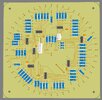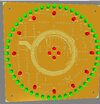As one of the members here struggles with an LED analog clock project, an idea for a simple LED clock design came to mind. This is somewhat similar to my servo Clock For Geeks idea. Usually, when you look at a wall clock, you don't need to know the exact time. "About" is close enough. On my servo clock, resolving quarter hours was easy but it could be read fairly accurately.
LEDs don't easily replicate the hands of an analog clock, at least without a multitude of them. Following the theme of my analog clock, an easy-to-understand "about" clock is pretty simple. A ring of 60 LEDs (60 to preserve the ability to display minutes, but 48 works better for this idea) displays not minutes, but hours. As the hours progress from noon to midnight, the ring is progressively illuminated (and repeated from midnight to noon). The ring of LEDs can be controlled by eight 74HC595 shift registers.
Inside the ring of 60 (or 48) LEDs are 12 LEDs to indicate the hour positions. These LEDs will always be illuminated, probably dimmer than the outer ring. To maintain flexibility, I would operate these 12 LEDs from two separate 74HC595s, with the enable input controlled by a pwm pin.
So why didn't I post that in the existing thread? That thread has reached 20 pages and the member is still lost in the woods. I didn't want to provide further distraction or have this idea buried in the weeds.

Servo Clock - Yes. Yes It Does Indicate 4:20
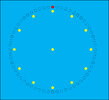
Noon
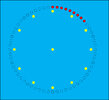
1:36
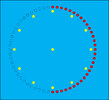
6:00
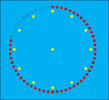
9:24
LEDs don't easily replicate the hands of an analog clock, at least without a multitude of them. Following the theme of my analog clock, an easy-to-understand "about" clock is pretty simple. A ring of 60 LEDs (60 to preserve the ability to display minutes, but 48 works better for this idea) displays not minutes, but hours. As the hours progress from noon to midnight, the ring is progressively illuminated (and repeated from midnight to noon). The ring of LEDs can be controlled by eight 74HC595 shift registers.
Inside the ring of 60 (or 48) LEDs are 12 LEDs to indicate the hour positions. These LEDs will always be illuminated, probably dimmer than the outer ring. To maintain flexibility, I would operate these 12 LEDs from two separate 74HC595s, with the enable input controlled by a pwm pin.
So why didn't I post that in the existing thread? That thread has reached 20 pages and the member is still lost in the woods. I didn't want to provide further distraction or have this idea buried in the weeds.

Servo Clock - Yes. Yes It Does Indicate 4:20

Noon

1:36

6:00

9:24
Last edited:


